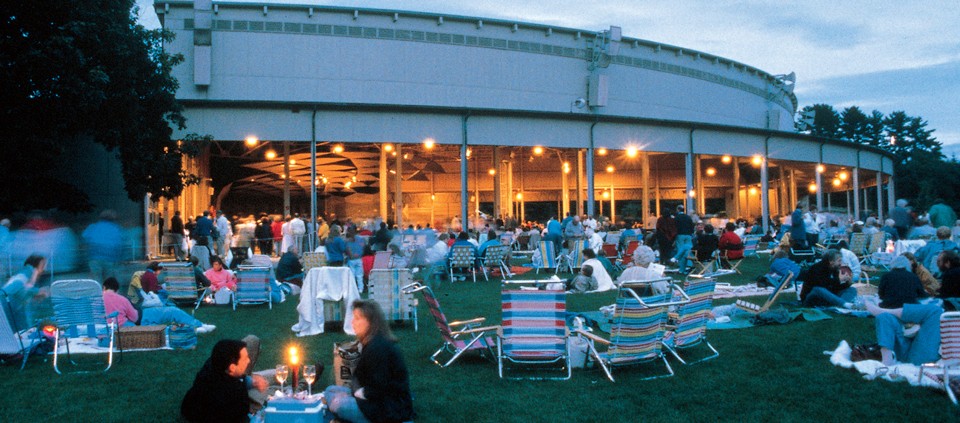Four Surprising Ways That Doing Yoga and Listening to Music Are More Similar Than You Think

Relaxed, alert, inspired, uplifted, content. Those are words you might use to describe how you feel after a great yoga class—or after an amazing concert.
Sitting absolutely still in a concert hall and moving through postures in a yoga class might seem like entirely different experiences, but there’s a similar alchemy that occurs, according to Marc Mandel and Larissa Hall Carlson, who coteach programs at Kripalu focused on the intersection of yoga, music, and mindfulness.
“After I started doing yoga and meditation, it began occurring to me that there are some seemingly obvious parallels with music,” says Marc, who’s been on the staff of the Boston Symphony Orchestra (BSO) since 1978.
In their programs, Marc and Larissa lead participants through experiences that enhance their ability to listen—including breathwork, movement, and meditation that bring them to a place of grounded, focused mindfulness. “We move from the gross to the subtle, from physical movements to help them relax, loosening up areas of tension and tightness, to gentle breathing to bring them deeply inward, to a meditation on sound,” says Larissa, a longtime faculty member for the Kripalu Schools and former Dean of the Kripalu School of Ayurveda.
Discussion is also part of the preparation: The group shares what it feels like to engage in listening as a whole-body activity. “We avoid technical talk and draw on visual language instead—color, texture, dynamics—as well as whatever other kinds of imagery or feelings one might experience while listening. You don’t need special training or vocabulary to respond to music,” says Marc, who originated “BSO 101,” a free adult-education music appreciation series offered at Symphony Hall in Boston, at Tanglewood (the summer home of the BSO), and in communities throughout the Boston area.
After preparing on both the mental and physical levels, participants try out their new practice of listening at Tanglewood, one of the most revered concert venues in the country, which happens to be just across the street from Kripalu. It’s a familiar venue not only for Marc, but also for Larissa, who taught yoga to Tanglewood musicians for the past 11 summers as part of a program originally launched by Kripalu to study how yoga impacts performance anxiety. (It helped!) Larissa says her appreciation for classical music has grown exponentially through this work—just as Marc’s dedication to his yoga practice has evolved and now impacts every aspect of his life, he says.
Whether you’re a yoga practitioner, a yoga student, a musician, a music lover—or someone who’s never done yoga or listened to classical music before—tuning in (pun intended) to both experiences can enhance your well-being and your capacity for joy. Here are four things that happen when we open ourselves to listening deeply to music (preferably live music!) and/or to practicing on the yoga mat.
We learn to focus our attention on the present moment.
Part of what’s so beneficial about both music and yoga is their ability to quiet the wandering mind and bring us deeply into our experience of the here and now. “When we’re listening mindfully to music or when we’re practicing yoga, our body awareness and senses are heightened,” Larissa says. “We become super-attentive to all the different sounds and to the sensations in our body—the sound, sight, and flavor of the experience. There’s a one-pointed focus of mind and state of concentration.”
The benefits of enhanced mindfulness are both mental—increased calm and clarity, greater happiness levels, and more creativity—and physical. Scientists have found that mindfulness practice decreases blood pressure; increases telomerase activity, which is associated with protection against cancer; and boosts immunity.
We learn to go with the flow.
“Music happens in time—it’s constantly changing, moment to moment,” Marc says. “There’s a sense of flow to the listening process: You sense the movement through time but you’re also immersed in the moment even as the music moves along and takes you with it.” It’s similar to the flow state that’s created in a yoga class, which in turn reflects the off-the-mat experience of “riding the wave”—moving through sensations and emotions with awareness and compassionate self-observation.
“These are simple, sustainable tools that people can take into their lives—body awareness, breath, focusing our attention, being curious,” Larissa says. “These things translate into the way we do anything and everything, whether it’s listening mindfully or doing the dishes.”
We build connection with others.
Studies suggest that, as a group of yoga students breathes and moves together, a mental synchronization is taking place as well. That also happens in a concert hall, as the rhythm and emotional resonance of the music bring the audience and performers into a common experience.
“There’s a shared energy, comparable to the energy one shares in a yoga and meditation class,” Marc says. A yoga teacher—like a conductor—helps create the experience, shaping what Marc calls “a meaningful, cumulative whole that brings everyone together.”
We embrace our own unique experience.
Just as no two people have the exact same experience in a yoga class, no two people listen exactly the same way, either. We might use a common language to describe what we feel or hear, but the textures, imagery, and memories that the experience conjures up are unique for each person.
“Each yoga student and each listener has a different reaction to what they’re doing or hearing,” Larissa says. “Both yoga and music can stir things up in the subconscious, bringing up old, unexpressed feelings of joy, sadness, or grief that can then be digested—or you might discover something totally new. Both practices allow us to more fully experience the different sides of ourselves.”
Find out about upcoming programs at Kripalu with Marc Mandel and Larissa Hall Carlson.
© Kripalu Center for Yoga & Health. All rights reserved. To request permission to reprint, please e-mail editor@kripalu.org. Photo by Stu Rosner.